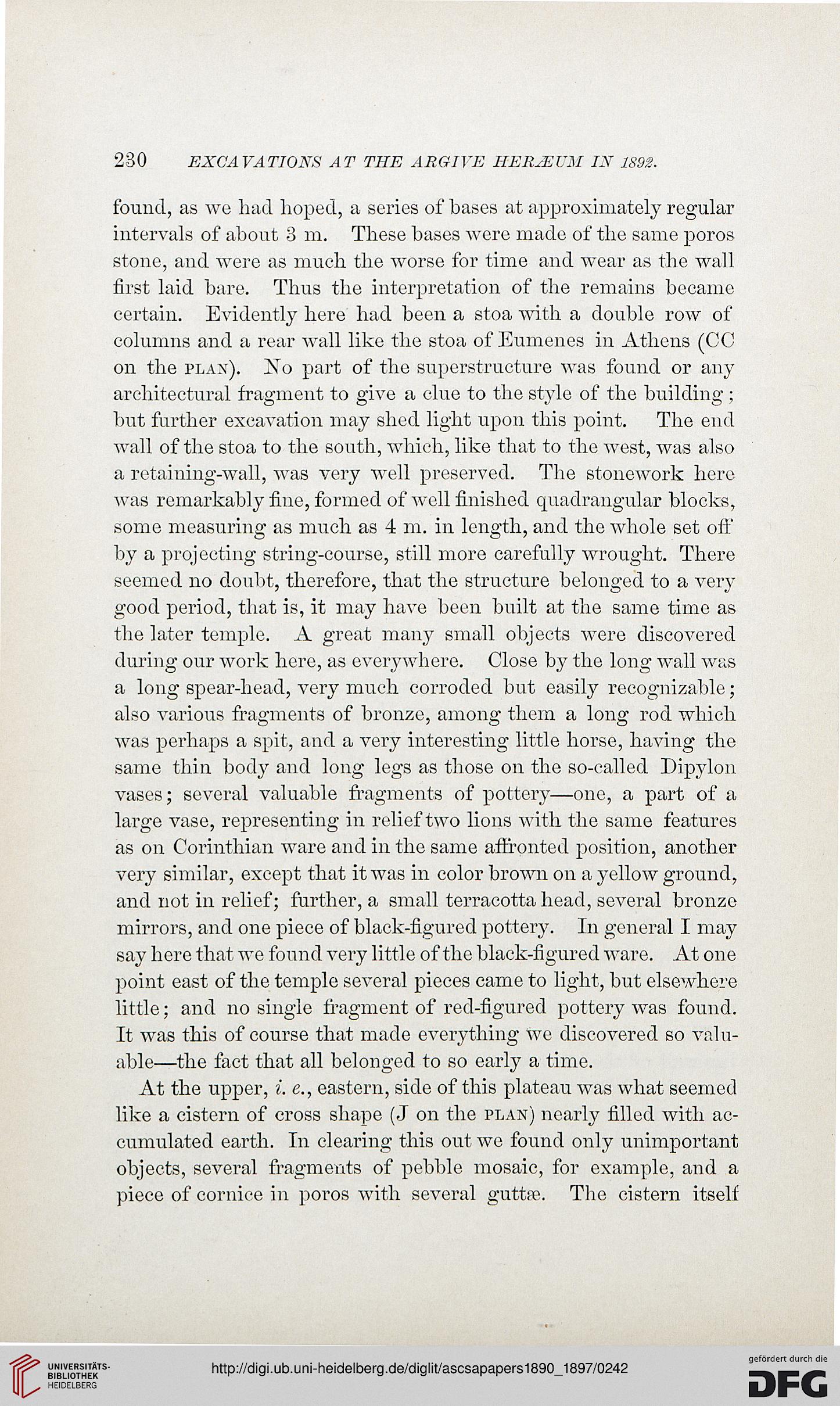230 EXCAVATIONS AT THE ARGIYE HER2EUM IN 1892.
found, as we had hoped, a series of hases at approximately regular
intervals of about 3 m. These hases were made of the same poros
stone, and were as much the worse for time and wear as the wall
first laid bare. Thus the interpretation of the remains became
certain. Evidently here had been a stoa with a double row of
columns and a rear wall like the stoa of Eumuncs in Athens (CC
on the plan). No part of the superstructure was found or any
architectural fragment to give a clue to the style of the building ;
but further excavation may shed light upon this point. The end
wall of the stoa to the south, which, like that to the west, was also
a retaining-wall, was very well preserved. The stonework here
was remarkably fine, formed of well finished quadrangular blocks,
some measuring as much as 4 m. in length, and the whole set off
by a projecting string-course, still more carefully wrought. There
seemed no doubt, therefore, that the structure belonged to a very
good period, that is, it may have been built at the same time as
the later temple. A great many small objects were discovered
during our work here, as everywhere. Close by the long wall was
a long spear-head, very much corroded but easily recognizable;
also various fragments of bronze, among them a long rod which
was perhaps a spit, and a very interesting little horse, having the
same thin body and long legs as those on the so-called Dipylon
vases; several valuable fragments of pottery—one, a part of a
large vase, representing in relief two lions with the same features
as on Corinthian ware and in the same affronted position, another
very similar, except that it was in color brown on a yellow ground,
and not in relief; further, a small terracotta head, several bronze
mirrors, and one piece of black-figured pottery. In general I may
say here that we found very little of the black-figured ware. At one
point east of the temple several pieces came to light, but elsewhere
little; and no single fragment of red-figured pottery was found.
It was this of course that made everything We discovered so valu-
able—the fact that all belonged to so early a time.
At the upper, i. e., eastern, side of this plateau was what seemed
like a cistern of cross shape (J on the plan) nearly filled with ac-
cumulated earth. In clearing this out we found only unimportant
objects, several fragments of pebble mosaic, for example, and a
piece of cornice in poros with several guttse. The cistern itself
found, as we had hoped, a series of hases at approximately regular
intervals of about 3 m. These hases were made of the same poros
stone, and were as much the worse for time and wear as the wall
first laid bare. Thus the interpretation of the remains became
certain. Evidently here had been a stoa with a double row of
columns and a rear wall like the stoa of Eumuncs in Athens (CC
on the plan). No part of the superstructure was found or any
architectural fragment to give a clue to the style of the building ;
but further excavation may shed light upon this point. The end
wall of the stoa to the south, which, like that to the west, was also
a retaining-wall, was very well preserved. The stonework here
was remarkably fine, formed of well finished quadrangular blocks,
some measuring as much as 4 m. in length, and the whole set off
by a projecting string-course, still more carefully wrought. There
seemed no doubt, therefore, that the structure belonged to a very
good period, that is, it may have been built at the same time as
the later temple. A great many small objects were discovered
during our work here, as everywhere. Close by the long wall was
a long spear-head, very much corroded but easily recognizable;
also various fragments of bronze, among them a long rod which
was perhaps a spit, and a very interesting little horse, having the
same thin body and long legs as those on the so-called Dipylon
vases; several valuable fragments of pottery—one, a part of a
large vase, representing in relief two lions with the same features
as on Corinthian ware and in the same affronted position, another
very similar, except that it was in color brown on a yellow ground,
and not in relief; further, a small terracotta head, several bronze
mirrors, and one piece of black-figured pottery. In general I may
say here that we found very little of the black-figured ware. At one
point east of the temple several pieces came to light, but elsewhere
little; and no single fragment of red-figured pottery was found.
It was this of course that made everything We discovered so valu-
able—the fact that all belonged to so early a time.
At the upper, i. e., eastern, side of this plateau was what seemed
like a cistern of cross shape (J on the plan) nearly filled with ac-
cumulated earth. In clearing this out we found only unimportant
objects, several fragments of pebble mosaic, for example, and a
piece of cornice in poros with several guttse. The cistern itself





